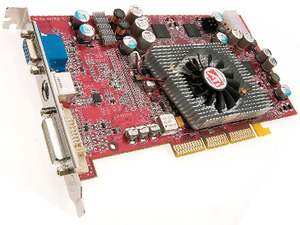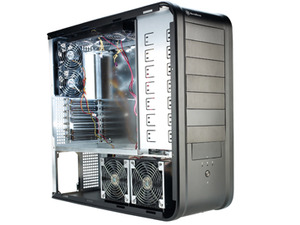
ATI Radeon 9700 Pro
Launched August 2002Inducted for The card that put Nvidia on the back foot, and ushered in seven years of fierce rivalry in graphics
By 2000, 3dfx had turned from trailblazer to turkey with the Voodoo 5. With its masterful GeForce 256, Nvidia settled comfortably on 3dfx’s throne and started having the graphics crown adjusted to permanently rest atop the GeForce name. ATI’s Radeons were present and correct, but it wasn’t until the Radeon 9700 Pro at the end of the 2002 that they really gave Nvidia a thrashing. Clocked at a then cutting-edge 325MHz, the 9700 Pro featured eight pixel and four vertex pipelines, and a 256-bit wide memory interface – yes, the same width that’s used by ATI Radeons today. Even more amazing when compared with current graphics cards, it was powered by the old 4-pin connector that used to run 3.5in floppy drives.
The 9700 Pro beat the competing GeForce 4 Ti 4600, although that GPU was nearly six months older; a true head-to-head battle came when Nvidia launched the GeForce FX and ATI came to market with the Radeon 9800 Pro (pictured). It’s a testament to the strength of the 9700 Pro’s design that all ATI really had to do for the 9800 Pro was increase the clock speed (to 380MHz) and tweak the shader performance. It was a brilliant GPU, capable of gaming at resolutions up to 1,600 x 1,200 with anti-aliasing – and revealed the GeForce FX as the truly terrible product it was.
The Radeon 9800 Pro was faster, cooler, more compact and cheaper. Best of all, though, this tough competition forced Nvidia to respond with a much improved design (the excellent GeForce 6-series), and firmly established ATI as a serious, capable rival to Nvidia. ATI’s Xbox 360 design victory and the buy-out by AMD both have their roots in the success of 9700 and 9800 Pro.


Left: The Radeon 9800 Pro, based on the excellent 9700 Pro GPU; Right: SilverStone's TJ07 case has yet to be bettered when it comes to watercooling
SilverStone Temjin TJ07
Launched Spring 2005Inducted for Redefining a case for water cooling
While CPUs and GPUs are among the most expensive computer components to research and develop, they advance at a rapid rate. Case design proceeds more slowly. The firms making the cases are far smaller than the big chip companies, and when building a computer, many PC builders, be they individuals or companies, just want the cheapest metal box they can find. In addition, the way that most PCs are cooled – a fan at the front pulling in air and another at the back pushing it out – is set in stone. Even Intel couldn’t change this (remember BTX?).
Given that there’s so little incentive to change case design beyond cheap gimmickry, it’s hardly surprising that SilverStone’s Temjin TJ07 has been the water-cooling case of choice for years. The TJ07 forgoes a front intake, instead having fans in a discreet bottom compartment to cool hard disk drives, and fans at the back and top to cool the main chamber. This allows SilverStone to make the front from a single piece of aluminium, bent into a U-shape, giving the TJ07 a unique appearance – unlike many PC cases, it’s powerful and sleek without being loud and lairy.
The bottom compartment, though technically for hard disk drives, is also perfectly sized for a quad 120mm-fan radiator, and as it’s a separate compartment, you can neatly feed the necessary tubing into the main part of the case while hiding unwanted clutter. As the case has seven 5.25in drive bays, you don’t lose anything in terms of mounting points for storage drives either.
The TJ07’s unique water-cooling abilities first came to the attention of many UK enthusiasts in the PCs built by the now defunct Vadim Computers – beautiful, neat creations that redefined how a water-cooled PC should look and perform. The TJ07 has very deservedly been a staple of our sister mag Custom PC's annual Dream PCs Labs test since 2007.

MSI MPG Velox 100R Chassis Review
October 14 2021 | 15:04








Want to comment? Please log in.